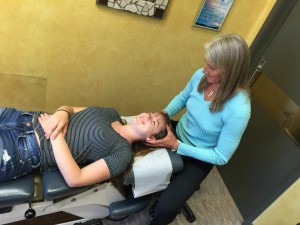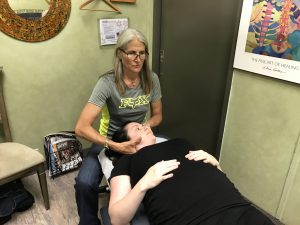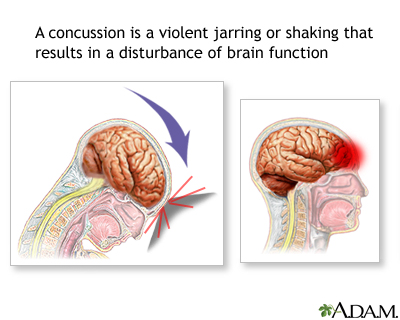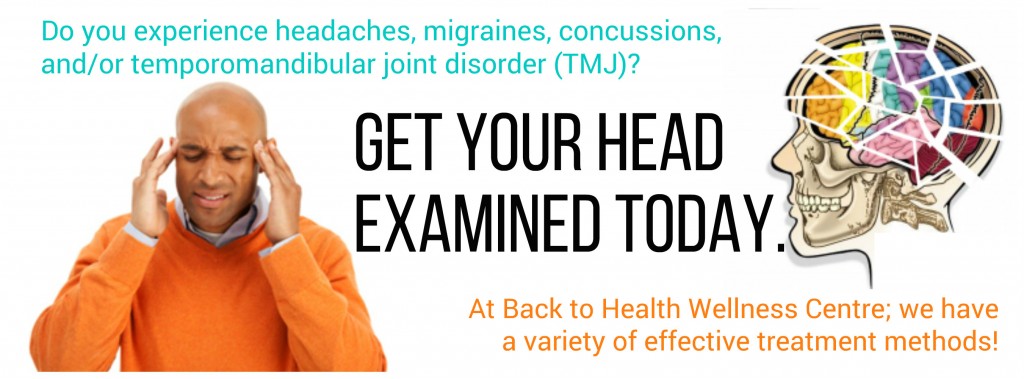About concussions
Concussions are now taken more seriously than ever before in both professional and amateur sports, as well as amongst the general public. Improved awareness of concussion symptoms and emphasis on their significance has led to improved treatment outcomes for patients.
A concussion is when the brain violently strikes the inside of the skull, resulting in a bruise. This can happen from either a direct blow to the head, or from a violent movement of the head & neck with minimal or no contact, as is the case with whiplash.
The swelling of the brain tissue, which happens when any type of tissue is bruised, is what causes the unfavourable symptoms associated with a concussion. Symptoms may be severe and linger for extended periods of time.
Symptoms vary widely and may include blurred vision, dizziness, emotional or mood changes, headache, loss of concentration, memory loss, nausea, ringing of the ears, vomiting, and more. However, loss of memory or consciousness is not necessarily a symptom of even serious concussions.
Early diagnosis is important. Refraining from activity that could further damage the brain is critical in reducing symptom duration and recurrence.
About headaches and migraines
Did you know that 8 out of 10 headaches/migraines are neck, TMJ (jaw joint) and skull related?
Headaches and migraines can also be the result of other disturbances in the body. This is why treatments with pain-relief medications often just act to suppress a much deeper, underlying trigger. Changes in circulation and the micro-vessels of the cranium can lead to swelling or vasodilation of these blood vessels and an increase in pressure. This can be triggered through tension (psychological or muscular), histamine release (through allergenic triggers including food or environmental sensitivities) and increases in inflammation or platelet clumping.
Headaches and migraines are common pain events for many people, and they are often recurring. A variety of prescription and over-the-counter pain relievers may control headache and migraine pain, but they only mask the pain without addressing the cause. These pain relievers may also have side effects, especially with long-term use.
What do you do when you suffer from a pounding headache or migraine? Do you grit your teeth and carry on? Lie down? Pop a pill and hope the pain goes away? There are better alternatives.
Treatment options
Chiropractic
Hoping to find a more natural and holistic solution to chronic headaches, migraines and concussions? Many people are now turning to chiropractic. And most patients start to feel better after one treatment!
Clinical studies suggest that chiropractic may have a measurable role in the prevention of migraines and headaches. Through adjustments of the spine, neck, jaw and skull, migraines and headaches can often be reduced or prevented. Nerves control vascular system tension, and chiropractic adjustments reduce irritation of the nervous system beginning with its roots in the spine, also improving vascular flow.
Chiropractors also receive extensive training in the recognition of concussion symptoms due to the high incidence of this injury amongst chiropractic patients. An often-overlooked component of concussion treatment is the neck injuries that frequently accompany the concussion. If you or your child has suffered one or more concussions, regular chiropractic adjustments will complement any medical treatments you may be having.
A variety of adjustment options are available, depending on what the patient would like and prefer. For instance, some patients are not fond of the ‘cracking’ noise with a neck adjustment; the neck adjustment can then be changed to several other types of treatment that do not cause the noise.


Cranial Adjusting Turner Style (C.A.T.S.)
Modern advances in brain research and imaging have proven that the sutures to the bones in the skull contain blood vessels, nerves and connective tissue, all within a space 1/100th of an inch across. They help nourish the cranium and facilitate movement of the bones that form the skull. The impact of a concussion can knock bones out of alignment and cut off the circulation within these sutures. Because the skull bones are still misaligned from the trauma, it’s difficult for normal brain function to be restored.
Post-concussion symptoms can remain long after the original trauma. Headaches persist, brain fog does not lift and disorientation can completely take over every aspect of a person’s life.
Cranial Adjusting Turner Style (C.A.T.S.) is a breakthrough technique for correcting the misalignments in the skull caused by the trauma involved in concussions and post-concussion syndrome. C.A.T.S. can realign the bones and restore proper circulation of cerebral spinal fluid and blood to the nerves and tissues damaged by misaligned bones. This treatment has helped many concussion sufferers get back to their lives more quickly than the traditional treatment protocols. C.A.T.S. practitioners are able to detect and correct any cranial misalignments. They function under the basic principle that if a cranial bone is out of place, put it back into place and restore its function.
Registered Massage Therapy
We now know that a concussion is a bruise. As with all bruises, they will take time to heal and repair. The nutrients required to help heal a bruise are delivered via the circulatory system. It is essential to increase blood flow to these affected areas without increasing blood pressure. Registered massage therapy for headaches and migraines is a great solution. Massages de-stress your body, lower your blood pressure and increase circulation.
The relaxing effect of massage helps the body produce endorphins, which causes the body to naturally find a state of relaxation. This relaxation stops swelling, thereby decreasing the intracranial pressure. Patients with concussion and post-concussion syndrome need to be treated to assist in healing of the neurological, vascular and autonomic components of these injuries. Cranio-sacral therapy (CST) is one approach that may be applied by experienced therapists to facilitate this process. CST is a gentle, hands-on method of evaluating and enhancing the functioning of a physiological body system called the craniosacral system – a system comprised of the membranes and cerebrospinal fluid that surround and protect the brain and spinal cord. Using a soft touch generally no greater than 5 grams, or about the weight of a nickel, practitioners release restrictions in the craniosacral system to improve the functioning of the central nervous system.
Cupping Therapy
Cupping therapy can help with tension in the neck, shoulders, and upper back related to headaches, migraines, and concussions.
Functional Range Release
Similar to Active Release Techniques (ART), there is a complete set of protocols for treating the head, spine, and pelvis. The palpitation in Functional Range Release is a better way of locating tight muscles and better identify what is causing the pain in the head, neck and back.
TMJ treatments
The jaw has a direct relationship between the skull and the neck. People with headaches, migraines or concussions often have issues with their jaw, which are sometimes not addressed by health care providers. To find relief from your concussion symptoms, TMJ treatments may help!
Other therapies to try for Concussion treatment
Breathing
Increase oxygen to the brain for faster healing. Specific breathing exercises can range from abdominal breathing, to the stimulating breath (also known as the bellowing breath), to the 4-7-8 (or the relaxing breath), to breath counting!
Hydrotherapy
Hydrotherapy uses changes in temperature to stimulate your circulatory system by dilating and then constricting blood vessels in a cycle from hot to cold. This process can also be done in the shower by changing the water temperature. For vascular headaches, putting your feet through this cycle of hot and cold water can help draw blood from the head to the feet and alleviate symptoms.
Meditation, Pilates and yoga
Consider trying meditation, Pilates and yoga to help relieve the symptoms from headaches, migraines or concussions.
Nutritional support
Headaches, migraines, and post-concussion syndrome can all be impacted by inflammation. Get dietary advice regarding foods that help to reduce inflammation, supplements, and botanicals.
- Make sure you get adequate hydration with a variety of fluids. Be sure to add to your water intake when drinking coffee and other diuretics. Drink coconut water to help restore electrolytes.
- Consider food testing to help guide your dietary changes.
- You can also log a daily food journal to better understand your current patterns, and see where changes can be made to better reduce inflammation, find deficiencies and support healing.
- Add 2-4 tablespoons of coconut oil per day to your diet.
- Supplements such as coenzyme Q10, fish oils, glucosamine, ginger, iron, magnesium, Petadolex, turmeric and vitamins B & B12, C, D and E can help.
Sleep evaluation
Having a sleep evaluation can help determine if you need a better mattress, a more supportive pillow or even if you need to change your sleep positions and habits to help heal your body and give it ongoing support. You may even need a mouth guard if you grind your teeth at night!



